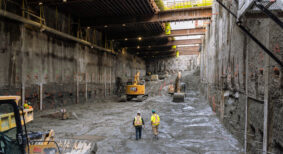Slips, trips, and falls are the costliest workplace incidents and some of the biggest causes of general productivity loss, according to WorkSafeBC.
WorkSafeBC reports that some 7,000 workers suffer injuries due to slips, trips, and falls every year. Approximately 20 per cent of workplace injuries are related to these injuries.
In the past six years, almost 41,000 workers in B.C. suffered slip-trip-and-fall injuries, including fractures, sprains, and dislocations.
On average, slip-trip-and-fall injuries cost B.C. businesses 440,000 lost workdays and more than $148 million in claim costs each year. Construction is one of the most impacted sectors.
“Slips, trips, and falls can lead to debilitating injuries that impact both workers and businesses alike,” explained Barry Nakahara, senior manager, prevention field services at WorkSafeBC. “The good news is the majority of slip-trip-and-fall incidents are preventable, and the basic precautions are easy and cost-effective.”
The simplest way of preventing injuries from slips, trips, and falls in the workplace, according to the organization, is to develop and implement a risk management plan that uses the established hierarchy of controls to identify and assess controls, and to monitor safety hazards and risks.
Some examples are:
- Install electrical wires, cords, and hoses where they won’t create tripping hazards.
- Install covers, drip pans, containers, or containment rooms to prevent the release of contaminants from equipment to the floor.
- Make sure all tools, equipment, and materials are stored in their designated locations.
- Determine the right type of footwear for workers to wear based on the slip and trip hazards in the workplace.
During the winter months, icy and wet conditions contribute to an 11 per cent increase in injuries due to slips, trips, and falls. Nakahara said that changing workplace conditions — including changes in weather — mean that risk assessments must be revisited on a regular basis.









